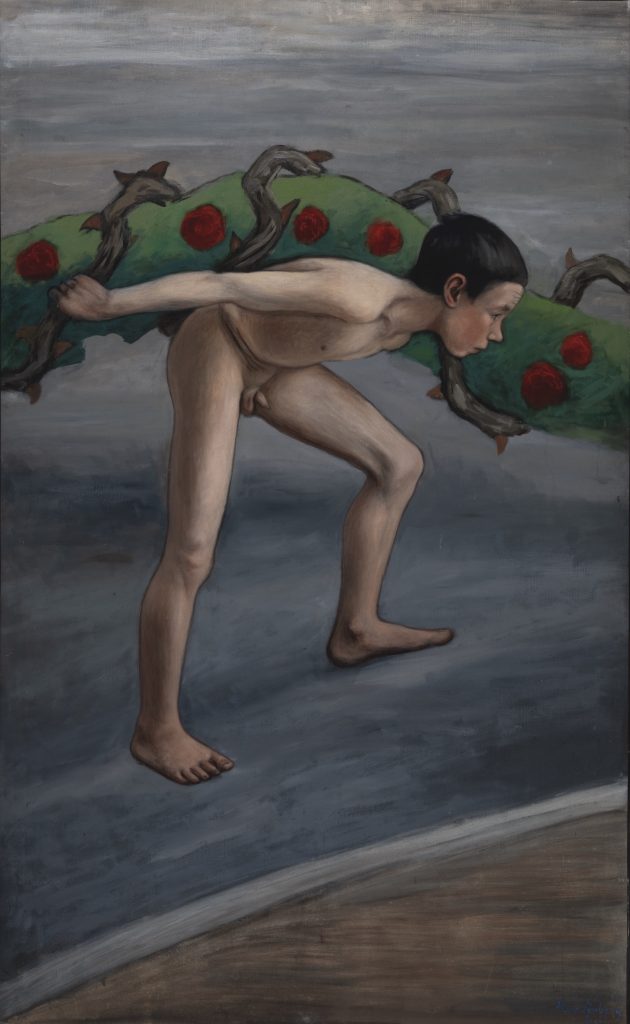Hugo Simberg
Garland Bearer, 1905
JANUARY 2020
In the autumn of 2019, The Gösta Serlachius Fine Arts Foundation acquired to its collections Hugo Simberg’s (1873–1917) painting Garland Bearer (1905), which is one of the studies for the painting on the gallery rail of the Tampere Cathedral depicting boys bearing garlands. The artist made an oil painting of each one of the boys in proportions corresponding to those of the rail.
Nowadays, two of them belong to Ateneum’s art collection, two belong to the collection of Helsinki Art Museum HAM and one belongs to the collection of Hämeenlinna Art Museum. The rest, as far as we know, are privately owned.
Between 1904–1907, the artist Hugo Simberg accomplished an arduous work decorating the interior of St John’s Cathedral in Tampere (nowadays Tampere Cathedral) together with the artist Magnus Enckell (1870–1925). The work of decorating the church planned by architect Lars Sonck (1870–1956) was divided so that Enckell took care of the altar fresco and the apse and Simberg decorated the church hall. No conditions were set for the artists as to the motifs or methods of carrying out the task, but they were given a free hand in their artistic work.
Simberg moved to Tampere for carrying out the work. In 1905, he rented a studio on the fifth floor of the Palander house by the central plaza in Tampere. In his studio, an abundancy of drawing and painting sketches related to the church were born. The artist even installed an electric lamp there, in order to dispose of a maximal number of working hours. In those days, electric illumination was still something highly uncommon.
As one of his picture motifs, Hugo Simberg painted a 52 metres broad painting for the gallery rail of the church, showing twelve naked boys walking through a grey unknown landscape holding a garland. With his work, the artist has described the different attitudes people have toward life. One of the boys has difficulty carrying his burden, while another carries his lightly, and still another with resolute steps. One interpretation has been that the boys are representing the twelve apostles of the Bible. As to their age, they are between childhood and youth. They don’t pose, but are carrying out their task seriously, without pretence. The artist hasn’t wanted to depict the boys as heroes, as was customary in the freeze paintings of the Antique, but as ordinary boys. Even earlier, Simberg had painted realistic character descriptions of children. He had the ability to make the character traits and essence of the persons he depicted crystallize in the portraits, which is visible also in this painting.
Simberg made careful preparations for carrying out the rail painting. He picked Tampere boys as models. The artist had a wooden platform made in his studio, following the forms of the lower edge of the gallery rail. The boys were posing on the platform carrying a model for the garland made of a piece of cloth filled with straw. Of these arranged positions, Simberg took photos which he used as starting points for his sketch drawings and paintings. Using the photos, he also composed the order of the boys in the painting. He also pondered on the composition and the ensemble using three-dimensional wax models. He had to carefully consider the positions of the boys, so that the rhythm would be right in relation to the arches and pillars of the church.
Before starting the actual work of painting, Hugo Simberg made a large-scale oil painting of each one of the boys, corresponding to the measures of the gallery rail. The painting which has been acquired to the collections of The Gösta Serlachius Fine Arts Foundation depicts a boy carrying a garland on his back, which is in a horizontal position. Even though the position is challenging, and the garland certainly is heavy, he is purposefully and steadily carrying his burden. You can discern a certain shyness in the boy, but at the same time, his respect for carrying out his task. The model for the Garland Bearer was Tuure Ilmoni (1890–1965) from Tampere.
In the autumn of 1907, Hugo Simberg and Magnus Enckell held a shared exhibition in the House of Nobility in Helsinki, showing sketches and paintings which were related to the work carried out in the church and which stemmed from the same period. The exhibition received a lot of attention and praise. Even the papers encouraged people to buy works for collections. The works were also shown the same year in the Turku Art Museum.
Eeva Ilveskoski
Curator
Sources:
Paula Kivinen, Tampereen tuomiokirkko. Helsinki: WSOY, 1986.
Helena Ruuska, Hugo Simberg: Pirut ja enkelit. Helsinki: WSOY, 2018.


